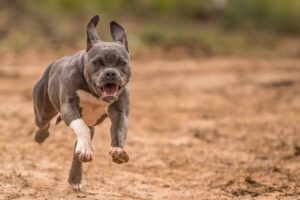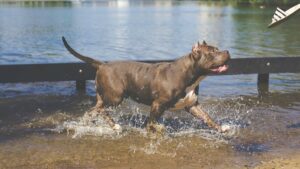Pitbull is among the most popular dog in the world. This dog has a lot of positive features that make them perfect for all dog lovers. They are intelligent, lovable, loyal and also friendly to kids. However, there are a lot of queries being raised about Pitbull’s temperature tolerance and coat. While some Pitbull owners claimed that their dog can withstand very low temperatures due to its thick fur others say their dog is more active and healthier when the temperature is high.
The contradicting answers gotten has made it difficult for new Pitbull owners to know about their dog temperature tolerance range. However, if you also fall in this category, you don’t have to worry anymore because the perfect answer to the query “What is my Pitbull temperature tolerance range?” will be given in this article.
Without further ado, let’s dive into the main reason for this article.
What is Pitbull’s Temperature Tolerance Range?

Pitbulls have just a single coat which is short and very close to their skin, this hair becomes thicker during the winter to help them regulate their body temperature. But is this enough to keep your Pitbull healthy during winter? Absolutely NO
Pitbulls survive more during summer than winter, they can live in a mildly hot environment without any adverse effects on them, but this is not the same when it comes to winter.
Excessive cold on your Pitbull will slower his metabolic activities and make him lethargic. It also leads to various health complications such as frostbite and hypothermia.
An environmental temperature lower than 400F (Cold) is dangerous for your Pitbull while a temperature higher than 950F (Hot) might also pose threat to your Pitbull.
The temperature tolerance range of your Pitbulls might also vary due to some factors such as age, coat color, and size.
What are The Factors That Determine Pitbull’s Temperature Tolerance Range?
The temperature tolerance range of all Pitbulls is not the same and this is because of some factors such as:
- Age: A younger Pitbull will withstand cold temperatures more than an old Pitbull because the rate of metabolism in an old Pitbull is low therefore making it impossible for the old Pitbull to produce enough heat that will help to stay warm in the cold environment.
- Body Size: A larger Pitbull tends to have more fats on its skin that acts as an insulating layer. These fats will make him withstand cold environments unlike Pitbull with a small body build.
- Coat Color: Pitbulls with darker coat colors such as blue fawn or black and white will absorb and conserve more heat that will keep their body warm. A dark-coated Pitbull will tolerate cold temperatures, unlike a light-coated Pitbull.
These three factors are the major reasons why Pitbulls have varying temperature tolerance ranges. While these three factors might be in favor of your Pitbull, this doesn’t mean you should expose your Pitbull to an unfavorable temperature for a long time, doing this might lead to health complications in your dog.
Pitbulls get cold easily during cold weather conditions, they show some outward visible signs when you expose them to colder temperatures for a long time. Prolonged exposure to cold will lead to serious health issues which can lead to the eventual death of your pooch.
However, you can prevent this from happening beforehand by knowing the signs Pitbulls show when they are cold and also things to do to make your dog warmer.
Keep reading because these two things listed above will be discussed in the next section.
What are The Signs That Show Your Pitbull is Cold?

There are some signs Pitbulls show when they are being affected by the cold environmental temperature. As a good pet owner, when you notice any of these signs in your Pitbull, kindly do things that will make them warmer or take them to seek professional advice if necessary.
These signs include:
- Shivering and Trembling: This is a very common sign that shows that your Pitbull is cold and is seeking warmth.
- Decreased activity: Your Pitbull will suddenly become lethargic, and your very active dog won’t want to participate in any fun activity.
- Seeking warmth: A cold Pitbull will keep huddling and try to stay in warm places. They might be staying closer to a heat source or huddling themselves under the blanket.
- Cold nose, ears, and paws: Check these three of their body parts, if they are very cold, this is a sign that your dog’s general body temperature has also dropped drastically.
- Excessive whining or barking: Dogs bark and whine to show that they are uncomfortable. When you notice that your Pitbull is howling like a wolf and barking aggressively during winter. This is a sign that your pooch is cold.
These signs are not uncommon when your dog is staying in an environment with temperatures below its temperature tolerance range.
If you notice any of these symptoms, you should kindly help your dog get warmer by increasing the number of their beddings or wearing heated pads and other safety clothes against cold. But if the symptoms persist, then you will have to visit a qualified veterinarian for proper health care.
How Can You Keep Your Pitbull Warm During Winter?
A good pet owner should be willing to help his Pitbull survive this unfavorable weather condition. By following the tips and safety measures that will be highlighted in this section, you will help your Pitbull live a healthy and comfortable life during winter.
Change their bed location to a warm or draft-free location.

You should consider changing the location of your Pitbull’s bed. Make it warmer and cozy, also add to their beddings and make use of heating pads for them.
Provide your Pitbull with enough food and water.
During cold days, ensure you provide your dog with food that contains necessary nutrients with an adequate number of calories or fats. Fats will help to improve the insulating layer on your dog’s skin, therefore, making his body warm.
Hydration will also help to keep your dog’s body warm at all times.
Dress your Pitbull in winter clothes.

If the environmental temperature falls below your Pitbull temperature range, you should consider dressing your Pitbull in warm clothing such as sweaters, coats, and boots. These gears will help them to insulate their body by trapping warm hair around their skin.
Reduce the time you spend with your Pitbull outside.
You should minimize the time you spend outside with your dog and spend most of the time with them indoors. You should go out with them only, when necessary, maybe during their regular exercise periods.
Ensure your dog doesn’t get wet.

During winter months, the number of times you bathe your dog in a month should be reduced, and also ensure they don’t get wet. A wet dog during winter will be exposed to the risk of having hypothermia.
Following these necessary precautions will help your dog live a comfortable life during the winter months. You should also endeavor to always take your Pitbull to your vet for health advice and medical check-ups.
What are The Potential Health Issues When Your Pitbull is Exposed to Cold Temperatures?
Being ignorant about your Pitbull’s temperature tolerance range is the worst mistake a Pitbull owner can ever make. Prolong exposure of your Pitbull to cold temperatures will lead to a lot of life-threatening issues such as:
- Hypothermia: This health condition occurs due to a drastic fall in the body’s general temperature. It impedes the flow of blood through your dog’s circulatory system, therefore, making some organs such as the heart, kidney, etc. stop receiving blood. Hypothermia is life-threatening and will require you to visit your vet.
- Frostbite: This health issue occurs when some tissues on your dog’s skin become frozen due to longer exposure to cold. Leaving frostbite untreated will lead to serious damage to the skin which might later result in amputation.
- Paw Damage: Prolonged exposure to snowy environments or cold floors will make your dog’s paw crack or damage. This can be very painful for Pitbulls, and it might make them unnecessarily aggressive. Application of Vaseline or coconut oil to the paw will help reduce the severity of the pain. Wearing your dog, a boot is also a nice safety measure but never apply anti-freeze or chemicals to your dog’s paw, doing this won’t help rather it will worsen the case for your dog.
- Decreased Immune System Function: Cold environment reduces the immune system function of Pitbulls, therefore, making them prone to illnesses and diseases.
Final Thought
Like other dog breeds, unfavorable weather condition affects Pitbull. This dog is known to be a strong dog but, they are easily affected when exposed to unfavorable weather conditions especially cold.
It is very necessary to always observe your Pitbull concerning any negative symptoms of being cold and also take necessary measures to help them keep warm and live comfortably. You can help to ensure the overall health and well-being of Pitbulls by taking care of them and monitoring their temperature tolerance range.
Before you go, you can also read:







Leave a comment